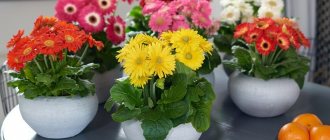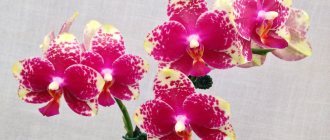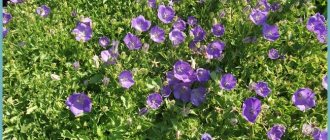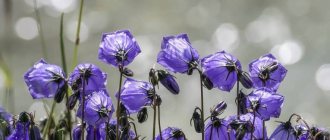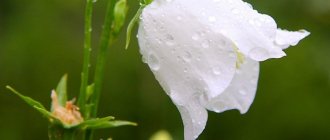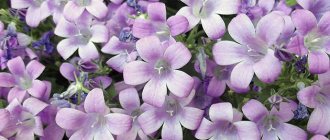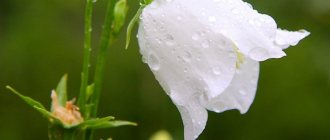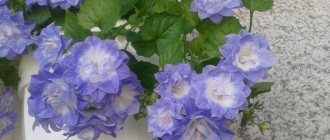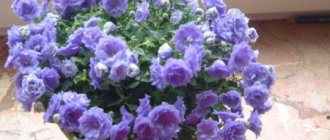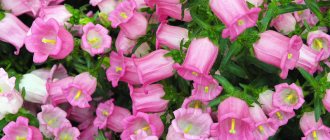- Reports
- Plants
- Bell
Campanula is a herbaceous plant belonging to the bellflower family. It grows mainly in latitudes with temperate climates. The bell is unpretentious to the soil; it can be found in forests, fields, steppes, desert and rocky areas. The plant got its name from the inflorescence, which is shaped like a bell.
The bellflower family includes more than 400 species. These are mainly perennial herbaceous plants; one or two-year-old plants are less common. The leaves of the flower are entire, alternately located on the stem. The inflorescence can have the shape of a panicle or a brush; sometimes there are plants with single flowers. The color of the bells is blue, purple, and white is also found.
Plants usually bloom in spring and summer. Their flowering period, depending on the species, varies from 15 to 90 days. There are bluebells blooming profusely in mid- and late summer. A common feature characteristic of all representatives of this plant species is the shape of the flower: a funnel-shaped corolla, with petals fused at the bottom and pointed at the top. There are also species whose flowers have a flat, cup-shaped shape. It is worth noting that bells have a pleasant honey aroma and are therefore distinguished by their good honey production.
The fruits of the plant are elongated capsules containing white or light brown seeds. Seeds remain viable for up to 5 years. The root of a plant is a compacted woody shoot with adventitious roots branching from it in different directions. The bell can be either low or tall.
Depending on environmental conditions, the appearance of the plant can be modified. So, with a lack of moisture, the bell leaves become wider and darker, and the inflorescence becomes duller in color.
Despite their widespread distribution, bells are found less and less every year in their natural habitats. This is due to the disruption of the ecology of their habitat, as well as the massive collection of a beautiful and useful plant. Most plant species are cultivated and are used by breeders in landscape design.
A story about a bell - a beautiful meadow flower
On the edges of the forest, as well as in the fields, you can see a herbaceous bush called the bell.
This flower is completely unpretentious. In nature, it grows in places with different climates. It can be found in the Caucasus, Siberia, and many other parts of our country. Today, human activity has led to the fact that this representative of the plant world is less common than before. The plant belongs to the bellflower family. In the Pskov region it is also called a bell. In ancient times, it was a decoration for both the estates of nobles and the flower beds of ordinary people.
The colors of the flowers vary: some are blue, purple, while others are white or pink. Most often, flowering occurs in June - July, but sometimes lasts until the first frost. The shape and size of the leaves differ among different species of this family. Their flowers are collected in panicles or brushes. When it rains outside, or at night, the bush closes them and lowers its heads down. This way it is protected from moisture getting inside. Insects often wait out bad weather in flowers.
The Campanula family is the scientific name of the genus Campanula. Photo: flickr.com/marilyllesoveran
Most bellflower species are perennials. They grow in one place for a long time. When the plant fades, instead of a flower, a fruit in the form of a box is formed. After a certain time, it cracks and the seeds spill out onto the ground.
The plant got its name because of the shape of the bud. Its petals grew together and formed something similar to a bowl or bell. Also, according to legend, once a year, on the night before the celebration of Ivan Kupala, the melody of these lovely flowers sounds over the meadows.
Report Bluebell in the Forest
Bellflower is a very beautiful herbaceous plant, which has more than 400 species. It grows mainly in meadows and forests, but is also found in the mountains. There are low species up to 50 cm in height, and there are also those whose stems reach 1.5 meters. The stem is often erect, but there are climbing and creeping types.
This plant owes its name to the shape of its bell-shaped flowers. According to legend, on the night of Ivan Kupala you can even hear them ringing. Flowers are often blue or purple, light or dark, less often white or pink. They are usually inclined downward and collected in panicle-shaped inflorescences. Because of their beauty, these flowers are collected, so they are in danger of extinction. This is also not worth doing because the bells collected in a bouquet wither very quickly, even if they are placed in water. If bells grow in dry places, their color is darker; in wetter places, they are lighter.
There are types of bells that are grown in gardens and flower beds. They are distinguished by larger flowers. This is a perennial plant, so clearings of bluebells bloom in the same place year after year. The bluebell usually blooms in mid-summer. After this, a fruit resembling a box is formed, from which small seeds fall out.
At night and when it rains, the bells are closed. They often provide shelter for insects. Bells have a pleasant honey aroma and contain a lot of pollen, which makes them good honey plants.
The bell is not only a beautiful, but also a very useful plant. Its various parts (flowers, stem, root) are used medicinally to treat coughs and headaches. A decoction of the plant fights microbes, so it is used to wash wounds, treat ringworm, and gargle.
Features and types of flower
The plant has a wide variety of species. There are about 150 of them in the world, and in Russia 15 of them grow. Today, many cultivated varieties have been bred. All of them became decorations of gardens and parks.
According to external features, all types of bells are divided into two groups:
Flowers may vary in both color and size.
Representatives of different species may differ noticeably from each other, but all have a flower in the shape of a small bell.
How is a bell useful?
The very first calling of this flower is to decorate parks and alleys. But it is also used in medicine. To treat diseases, all parts of the medicinal bush are taken - flowers, roots, leaves, seeds and stems. They make decoctions, powders, and tinctures. The most suitable time for collecting plants is the flowering period.
Bell decoction has the property of killing microbes. Therefore, it is used to treat cough, sore throat, headache, fever and other diseases. Poultices are used after dog bites to speed up wound healing. The plant also gives strength to weakened children. To do this, mothers add a decoction of it to the bath when bathing the baby.
Gardeners often plant bellflower to decorate the site.
In this report, we met a wonderful inhabitant of fields and forests, mountains and slopes - the bell.
Source
A story about a bell for children
In the fields and forests of our vast country there is a plant that is notable both for the shape of the flower and for its name.
This beautiful plant, the flower of which is painted in all shades of blue, is called “bell.” And this plant deserves its name - its flower is shaped like a real small bell. Campanula belongs to the genus of herbaceous plants of the Campanaceae family. Bells grow mainly in meadows, but they also like to settle in forest clearings, and some types of bells have even colonized mountain slopes. Mountain types of bells are short in stature, but at the same time they have large and beautiful flowers. Still would! After all, on the slopes the sun is more generous.
The bluebell is famous for its variety of species. There are more than a hundred different types of bells in our country. For example, in spacious meadows the most common species is the spreading bellflower. This plant has one peculiarity - it has a very weak, thin stem, so it grows well where other types of herbs are closely intertwined, which serve as a kind of support for the spreading bell. And it is called spreading because of its stem, on which many branches branch, covered with numerous flowers.
The bell-shaped flower of this plant is formed by the fact that its petals grow together and form a characteristic bell-shaped bowl. During the day, in good weather, the flower looks into the sky, and in case of rain or at nightfall, it will bend towards the ground. Since the fused petals cannot close at night, as happens with other flowers, this plant is loved by various insects, which climb into the “bell” to spend the night and warm up.
Beneficial properties of bell
The bell is not only a beautiful, but also a useful plant. An infusion of bells has antimicrobial and anti-inflammatory properties. It is used in the treatment of cough, migraine, and other diseases. And our ancestors used bell-based poultices for dog bites.
A little tale about a bell
...Once upon a time there was a bell. He stood alone by the road. He was sad. He had no friends. But then one day a cheerful little bee flew to him. She told her new friend her little forest secrets. The fidgety wind flew nearby and heard everything. But he didn't tell anyone anything. What for? He has his own life and his own interests. And the sun saw everything and smiled. It waved to the wind, its old friend, and continued its work of illuminating planet Earth...
This entry is password protected. Enter your password to view comments.
Source
Message about the Bluebell plant
Campanula belongs to herbaceous plants from the Campanula family. It got its name because of the shape of the flower. The bell grows on forest edges and sunny glades, in the steppe and in alpine meadows. There are more than 300 species of this plant in the world, in Russia - at least 150. Bells differ in size and different shades of colors. They can be from pale blue to lilac and dark blue. White bells are sometimes found. The stem of a plant can be simple or branched, creeping or creeping, it depends on its type. Bells begin to bloom at the end of May and until mid-August. Some plant species can continue to bloom in September. The ripe fruit of the plant is a box with seeds that remain viable for more than 4 years.
The most common types are crowded, nettle-leaved, peach-leaved and onion-leaved bells. Due to their beauty, many gardeners began to plant them in their garden plots. The crowded bell is distinguished by flowers closely pressed to each other. On one stem you can count up to 20 corollas. The nettle-leaved bell is similar in its leaves to nettles. Its flowers are deep blue with a purple tint. The peach-leaf bell is less than a meter in size, and its leaves are similar to those of a peach. Grows in fields and near paths. This plant is considered the most beautiful of the entire family, its flowers are sky-blue, so they were the first to be planted in gardens and garden plots in Europe. Onion-leaved bells are also distinguished by their beauty; the bright blue flowers are located seven to eight floors below each other.
Certain types of bells have medicinal properties. Their decoction is used as a tonic, for gargling, and in the treatment of rheumatism and joint pain. An infusion of dry bellflower herb is used to treat severe stomach pain.
In sunny weather, the bluebell flowers are always open. In rainy weather and at night, they close tightly and keep moisture and cold out. Inside the flower, as in a house, small insects often hide from the rain.
Many Russian folk songs, fairy tales and poetic works are dedicated to this delicate wildflower. Famous Russian poets Alexey Vasilyevich Koltsov and Alexey Konstantinovich Tolstoy wrote about them. In Rus', on the holiday of Ivan Kupala, young people gathered to listen to the silver ringing of small bells.
2nd grade. The world. 3rd grade
Bell flowers. The world
Bluebells are beautiful forest flowers. The shape of the flower resembles a large church bell, and the flower got its name from the word “bell”, only because of its size it is affectionately called, diminutively, bell.
It seems that the breeze will blow and the bell flowers will ring gently.
Bell
A gentle chime is flowing,
So it rings in the wilderness of the forest
The round leaves of the bell are located at the bottom and are collected in a basal rosette. There are small leaves in the middle, and larger ones at the edges.
There are always a lot of bells in the meadows and clearings, because whole families grow of them.
Bluebells bloom in May. The flower bud looks like a folded umbrella and is initially located horizontally. But when the buds open, the bell flower descends on the peduncle and looks down. Large insects - bumblebees and bees - can fly into the flower from below. While they get to the nectar located in the very depths of the flower, particles of golden pollen remain on their abdomen, back and legs. Flying to other bells, insects pollinate them.
Bells bloom for a long time, from May to September. At the end of summer and autumn, the bell fruits ripen. These are small boxes that, like flowers, look down. The bell box is a bit like a pepper shaker with small holes closed by valves. The valves open in dry weather and close in damp weather, protecting the seeds from moisture. This happens because in rainy weather the valves swell and close the holes through which seeds can spill.
There are various types of bells. There are dark blue, purple, lilac, blue, pink and even white bells.
And on the Canary and Azores islands, giant bells bloom, their stems are taller than human height!
Listen to the tale about the forest bells.
Bells and gnomes
A long time ago, in a dense forest, under the roots of an old hollow pine tree, there was a deep dungeon.
There, in an underground palace, lived cheerful, kind gnomes. At night they went out into the forest clearing. The breeze swayed small purple bells growing in the thick grass; they, ringing gently, told the gnomes about everything that had happened in the forest that day.
One day the bells told the kind little people that a helpless, recently fledged chick had fallen out of the robin's nest.
“Now he is sitting in the grass under a hazel bush. His feet are chilly from the cold night dew. The poor thing is very scared alone in the dark forest,” the bells rang in alarm.
The good gnomes immediately went down into the dungeon and, seizing the stairs, went to the hazel tree, under which the chick was hiding.
Fireflies lit their way, and the gnomes quickly found the baby, warmed him in their warm palms, calmed him down and carried him to a tree, in the thick branches of which the house of robins was hidden.
The most dexterous and brave gnome made it up the stairs to the nest and returned the chick to its parents.
Their joy knew no bounds! The robins thanked the kind gnomes for a long time. And the little people modestly answered: “The bells helped you, they told about the misfortune that befell your baby and helped save him.”
Questions for consolidation
What does a bell look like?
Why do bell flowers “look down”?
What insects pollinate bluebell flowers?
What do bell fruits look like?
What did you like (remember) about the fairy tale “Bells and Dwarves”?
Author: Shorygina Tatyana Andreevna
We recommend watching:
Legends about flowers for children, grade 2
A story about cornflower, grades 1-2
Conversation on the topic “Flowers” in the senior group
Riddles about flowers for children 6-7 years old with answers
Tales about flowers for older preschoolers
No comments yet. Yours will be the first!
Synopsis of the NOOD “Journey into the past of bells” in the preparatory group for school
Abstract of NOOD
on cognitive development
in the preparatory school group
Topic: "Journey into the past of the bluebell."
Software tasks:
- Introduce children to the history of bells and bells, their purpose and significance in human life.
- Expand children's vocabulary with new words - ringing, perezvon, coachman (podduzhny), bell ringer. Exercise children in sound-letter analysis of the word “bell”.
- To develop children's interest in the past of things, an ear for music, creativity, and imagination.
Vocabulary work:
bell ringing, bell, chime, bell ringer, coachman, podduzhny, door, ritual, bell, bell, collection, collector.
Material:
collection of bells, video, presentation “The History of the Bell,” bell ringing melodies for listening, a bell for each child, papier-mâché bells for decoration, bell stencils, beads, beads, colored paper, threads.
Preliminary work:
reading the true fairy tale “Why are Wolves afraid of the bell”, “The story of the bell”; viewing the album “Russian Bell”; games with bells; conversation with children about the collection of bells - shape, purpose, material.
Progress of the lesson:
Children enter the hall to the quiet sound of a bell ringing.
- Children, what is this melody? (bell ringing)
— What bells do we hear? (big, small)
- What is the sound of large bells and small bells?
- Bells... Low and high, thick and heavy, light, silvery, sad and cheerful, their voices were perceived as a gift from heaven - healing, elevating, protecting a person, his family, his home.
—Where can you hear the ringing of bells and bells? (in a church, in the Moscow Kremlin, at school, on wedding cars, in a store, etc.)
—Where did they come from and when did the bells appear? How are they born and how long do they live? Want to know?
The desire to know this and much more about bells takes us on a journey into the past of bells. And so - off we go.
(The melody of a bell sounds)
— The oldest bells are in the Veliky Novgorod Museum; they are over 500 years old. (Slide show #1)
— In Russia there were bell-making centers in Moscow, Nizhny Novgorod province, and Kostroma.
The work of the craftsmen is very diverse - they depicted ornamental shields and coats of arms of Russian cities on the bells. (Slide show #2)
The favorite theme of the masters was the image on the “body” “skirt” of the bell of St. George the Victorious, a protector from all adversities that travelers could encounter on the road. (Slide show #3)
— Where can you see the image of “St. George the Victorious” now? (on the coat of arms of Russia, on the coat of arms of the city of Moscow). (Slide show #4)
— There are church bells, fire bells, wedding bells, bells, railroad bells, ship bells, door bells, table bells, and souvenir bells. (Slide show #5)
- What flower does the bell and bells look like? (for a forest flower bell)
— According to legend, bells were first made by monks, repeating the shape of a forest bell. They also said that the masters went to the shore of the lake, where the girls sang melodies. And therefore, the shape of the bell repeated the silhouettes of the beauties, and the voices of the bells repeated their voices. To make a bell, inspiration and a special secret were required. (Slide show #6)
— Large bells were used at churches. That’s why they were called “God’s voice”
. Bells are placed either on the roof of the temple, in the dome towers, or at the entrances to the church, in the belfries, (Slide show No. 7) or near the temple in a special building for them, called a bell tower.
— The bells are called the Russian miracle. Bell ringing is the voice of our Motherland - the bells sound differently, telling about worries and joys, reporting disasters and holidays.
— Bell ringing has several names: alarm (Slide show No. 8 - video) In Russia, the bell sounded when meeting distinguished guests, when the enemy was approaching, the alarm was used to announce natural disasters, fires, and people gathered in squares for meetings.
- What is the name of the bell ringing that we just listened to?
— I suggest you listen to the “Blagovest” bell ringing, which sounds before the morning and evening services in the church. (Slide show No. 9 - video).
—Which bell do we hear first?
— First, the big bell strikes, and then the others.
- What bell ringing did we listen to?
-What is the name of the man who rings the bells?
— A bell-ringer is a “church minister who is obliged to ring bells according to ritual. According to an ancient tradition, on Easter week anyone can climb the bell tower (belfry) and try themselves as a bell ringer. (Slide show #10)
— What holidays in Rus' were there without riding on troikas, decorated with bells and bells, shimmering loudly as they rode? This joyful chime is an indispensable attribute of colorful, noisy fairs and bazaars, Christmas and Maslenitsa fun. At festive troikas, bells were used as a means of signaling - “give way!”
— Bells, they are called subarctic bells, are preserved today in one ancient folk ritual.
— In what ritual do you think bells can be seen?
(Slide show #11)
- And not in vain: the ringing of bells has always been considered a talisman against various troubles, troubles and misfortunes.
Game with a bell.
Children stand in a circle, the bells are also located in a circle. While the music is playing, children run in circles. As soon as the music is over, the children take the bells. Those who don't have enough leave the circle.
At the end of the game, the children take the bells with them and place them on the table.
— Bells come in a wide variety of shapes, purposes, and materials.
(Metal, glass, clay, porcelain, wood, birch bark) (Slide show No. 12)
— Why do you think they used to hang a bell on the neck of livestock – a cow, a goat, a calf, which was called a “botalo”? (Slide show #13)
— The fact that life in the old days was unthinkable without bells and the ringing of bells is evidenced by a large number of sayings and proverbs, which include the word “bell”
- Here are some bright sayings. Children read:
“People go to mass by ringing, and to dinner by calling,” “The ringing of bells is not a prayer, and a cry is not a conversation,” “In Moscow they rang for matins, but in Vologda they heard the ringing.” Here's a sign. “Ringing in the ears, in winter it means warmth, in summer it means bad weather.”
- Every bell and bell has a tongue - for ringing.
(Slide show #14)
Ears are “the opening through which a thing is lifted.” (Slide show #15)
—What is the purpose of bells and bells?
— The purpose of bells and bells is to ring, i.e. "to make a ringing sound."
We all have bells and we can test this statement.
Dima show me how your bell rings, Tanya show me.
Each bell has its own sound. And now we will all create a bell ringing together.
Children ring the bells that stand on their tables
- Please tell me, when we say the words bell, bell - how do they sound? (Hard, loud; soft, easy, beautiful)
I offer the children the word “BELL” to do a sound-letter analysis.
- What word is this? (long, consists of 3 syllables)
— How can you determine how many syllables are in the word “BELL”? (clap, bring your palm to your chin; there is a rule “As many vowel sounds in a word, there are as many syllables”)
Invite the children to lay out the word with colored sound chips, then replace the red (vowel sounds) chips with letters. The child works at the board at will.
Physical education minute
First we'll stomp, And then we'll clap, And then we'll turn around
And let's smile at each other.
- What fairy tales do you know that mention a bell?
(Slide show #16)
The Tale with Bells is Odoevsky’s “Town in a Snuffbox.”
(Show with a light pointer.)
— The fairy tale “Winnie the Pooh” by Alexander Milne and the story with the doorbell and Eeyore’s tail; "The Adventures of Cipollino" by Gianni Rodari.
— Amateurs, collectors of antiquities study the history of bells and collect them.
- What do you call a group of such objects? (Collection).
(Slide show #17)
“And now I suggest you add to our collection of bells, which we will make ourselves.” Take everything you need for work and start doing it - you can sit down or do the work standing, as is convenient for you.
Children doing work.
(Decoration of papier-mâché bells; bells made using stencils; decoration with beads, beads of a planar image of a bell)
Consider the bells made by children and add them to the general collection
3
Bluebell Carpathian
This is the most common inhabitant of garden rockeries and alpine slides. Very beautiful and fragile at first glance, it is distinguished by winter hardiness and the longest flowering period - 65-75 days.
Botanical description of the plant:
The plant propagates by seeds or by dividing the bush. In regions with mild winters it self-sows. Growing from Carpathian bellflower seeds is done through seedlings. Seeds are sown in February in boxes with fertile and breathable soil.
The seeds are very small, so they are scattered on a moistened surface and pressed down with the palm of your hand. Additionally, you can moisten the soil with a spray bottle.
Seeds are germinated in light under glass. Shoots appear after 2 weeks. After another 3 weeks, young sprouts dive into larger containers, followed by transplantation into open ground in May. Carpathian bellflower loves well-lit areas with drained soils. Does not tolerate stagnant water. In the garden they are planted with other ground cover at a distance of at least 20 cm, as it grows quickly.
Cultivated varieties include Carpathian bell Alba, White Star, Isabel, Centon Joy, which have white, purple and blue flower colors.
Bluebell Carpathian Alba
Bellflower peach
Distributed throughout the European part of Russia and other CIS countries. A recognizable inhabitant of wild meadows and forests. In nature, it most often has blue flowers and reproduces by self-sowing. Rarer varieties have white and purple inflorescences.
Bellflower prefers well-drained soils and partial shade. In nature, it is found on the edges of forests, in wet ravines, along river banks in the shade of bushes. When grown in the garden, it does not require fertilizing or watering. Used as a secondary and third plant.
Medium bell
A resident of the foothills of the Caucasus, Siberia and even America, the middle bell is a biennial herbaceous plant. Known in garden culture since the 16th century. Loves moist soils, coolness and does not tolerate heat and frost
In a favorable climate, the plant reproduces by self-sowing, the seeds ripen in August-September. The flower is considered a good honey plant. Its inflorescences bloom alternately from bottom to top, which is why it has such a long decorative period.
Cultivation of medium bellflower from seeds is carried out by planting in seedling boxes or in open ground. In the first case, you can achieve flowering of the biennial this year, and in the second case, in the future.
If you sow bellflower seedlings, choose the period from late January to February.
The seeds are not sprinkled with soil; they are germinated in containers in the light. The seedlings are transplanted to a permanent location in May-June. At first it is a dense rosette of leaves, which produces 1 stem with alternately forming buds. The bell will bloom in July of this year and next year in June.
To get a strong plant next year, the seeds are sown in open ground in June and lightly sprinkled with soil. Until autumn, the young rosettes will get stronger and are transplanted to a permanent place. The distance between plants is at least 10 cm. After 2 years, the planting is renewed.
Planting and caring for bells
There is no need to pre-prepare bellflower seeds for sowing. Sowing occurs in an open place in the last month of spring, or in October sowing is carried out for the winter.
For the bell to bloom this year, seedlings are sown around March. The best soil temperature suitable for seed germination is + 20 degrees. First, loose soil is prepared and small seeds are scattered over the surface of the ground. It should be light and have excellent water permeability.
And pay attention: it should be well moistened even before sowing.
Fertilizers are not required for the soil for bells, but they are prepared as follows:
- 6/10 of the soil composition should be turf;
- 3/10 of the soil composition should be humus;
- 1/10 of the earth should consist of sand, preferably coarse-grained.
Once the seeds are scattered, they are lightly pressed into the soil before moistening the soil with a spray bottle. Such crops must be covered with film and kept at a temperature of 20 degrees. Next, you need to wait 14 to 12 days for shoots to appear.
How to properly monitor seedlings
The shelter is removed as soon as the first seedlings begin to appear. The container will have to be removed from sunlight, as the sprouts need protection from it. This is the whole difficulty: the crop does not want to germinate in sunlight.
But they need to be placed in a place that will be well lit. And it wouldn’t hurt to spray them with water sometimes. This crop is grown like any other garden flowers. When the top layers of the earth dry out, they need to provide watering to the soil, and do not forget to loosen it periodically.
Three weeks after the seedlings emerge, young leaves will begin to appear, and during this period they need to be transplanted into a larger container, placing the plants at a distance of 10 cm. Fertilizer will need to be added to the ground, but not earlier than two weeks after transplanting.
Description of the plant
The field bell belongs to the family of herbaceous plants of the same name, which have flowers with the characteristic shape of a reduced bell. The structure of the stem can vary significantly. It is because of their appearance that these plants began to be called bells. The inflorescences consist of five serrated petals diverging upward, fused at the base.
Flowers can be natural and paniculate with large-sized multiple peduncles. The stem of bells, depending on the specific species, can be branched or simple, creeping or creeping in length. The plant may look like a shrub or a classic flower with a separate stem.
The flowering of bells begins in early spring and continues until the first days of August . There are also late species that bloom in September - October. Some varieties are distinguished by long flowering, the period of which can reach up to three months.
This is a common plant whose range extends from Scandinavia and the northern regions of Russia to the Pyrenees and the Apennine Peninsula.
Popular reports
Algebra is one of the main branches of arithmetic. This science is fundamental in the field of research into the specifics of computational operations and actions with various arithmetic quantities. This branch of science studies the sequence of solutions
The operating system of a computer is its most important component; it is what makes the “computer hardware” smart. The most common operating system is the Windows system.
The mosquito is the most common insect in our area. Mosquitoes belong to the family of dipteran arthropod insects, and their diversity throughout the world includes more than three and a half thousand species, of which about a hundred live in Russia.
READY REPORTS for school grades 1-11
- for free
- most popular topics
- adapted according to age
- competently
- written specifically for dokladiki.ru
Campanula is a beautiful plant that was named so because of the bell-shaped shape of its flowers.
Such flowers began to sprout in mountainous areas, and then appeared in forests and fields. Even in desert places and on rocks you can find a bell.
This plant lives in the Caucasus, Europe and Asia. Some species can also be found in North America. There are about 150 types of bellflowers in Russia!
This plant is a perennial herbaceous plant. But occasionally you can find annual flowers of the bellflower genus.
What does such an unusual plant look like?
The flowers are shaped like a small bell. The colors of the flowers are different. It can be white, lilac, blue and soft pink. The inflorescence of a bell is in the form of a brush or broom. The fruit is box-shaped, with 4 or 6 holes. The leaves are small, stemlike. Most often they disappear by flowering.
The height of the bell may vary. Depending on the type and place of growth, you can find both very small, barely noticeable flowers and tall, powerful plants. The bluebell can grow up to 1 meter in length!
These flowers bloom at the very beginning of summer. Some bells are always in a standing position, so they close their flowers at night. But in others, the flowers are lowered down day and night, so you can admire them at any time of the day.
This plant is perennial, but sometimes annual bells can also be found.
This flower is propagated by seeds and also by cuttings. If the plant is an annual, then it can only be propagated by seeds.
Despite the fact that the bell grows on its own, people willingly grow it in gardens and vegetable gardens. For what? This plant can be eaten due to its beneficial effects on the human body.
Bell infusion is often used to treat sore throats, colds and stomatitis. Also, a bath with the addition of a decoction of this plant has a calming effect on a person.
- Author: Maria Sukhorukikh
Rate this article:
- 5
- 4
- 3
- 2
- 1
(0 votes, average: 0 out of 5)
Share with your friends!
Step-by-step description of the master class
Learning to draw well is not easy, but if you work on developing your abilities, improve your technique and carefully study the theory, you can achieve a lot. To learn how to draw a bell, you will need patience and perseverance. Some actions will have to be repeated repeatedly, moving step by step towards the intended goal.
Bell - drawing for children
To work you will need the following tools:
The steps for drawing a bell are as follows:
Bell - drawing for children
Bell - drawing for children
Features and types of flower
The plant has a wide variety of species. There are about 150 of them in the world, and in Russia 15 of them grow. Today, many cultivated varieties have been bred. All of them became decorations of gardens and parks.
According to external features, all types of bells are divided into two groups:
Flowers may vary in both color and size.
Representatives of different species may differ noticeably from each other, but all have a flower in the shape of a small bell.
Common varieties
Due to their decorative nature and ease of care, bells are often used to decorate local areas; flower beds and unusual rock gardens are created on their basis. In ancient times, this flower was considered magical, and the first description of the bell was made 3 thousand years ago. Songs and legends were written about him, and numerous mysterious stories are associated with him.
Today, biologists conduct research and describe new plant species in their communications and reports. Its most common varieties are:
Breeders annually receive new bellflower hybrids that have an unusual appearance, are distinguished by characteristics, decorativeness and ease of care.
The main significance of the species is their use in landscape design. This is an excellent plant for novice flower growers and owners of private houses who want to decorate their home area without burdening themselves with complex gardening work. Some species are extremely rare in the environment, so biologists were forced to list them in the Red Book.
Popular topics today
If we talk about the monastic tradition, it is necessary to start with its origins, namely with the formation of the first monastery in Rus'. Such a monastery is the Kiev Pechersk Lavra
A small butterfly whose habitat ranges from Eurasia to some islands of the Atlantic Ocean. The admiral was included in the Russian Red Book, but was later removed from it
Russia has many climatic zones, which have their own characteristics of flora and fauna. The warmest region is Krasnodar. It is a center for tourism, sports and swimming. Nature is here too
In life, almost every second person has read or watched “War and Peace,” one of the brilliant works created by the talented writer L.N. Tolstoy. People came to him in Yasnaya Polyana from different
The problem of rational spending of funds exists in many families - even in those that can hardly be called poor. Accordingly, saving resources is a very pressing issue.
Honey mushrooms are a group of mushrooms. This name comes from the habitat, since most mushrooms grow on stumps and wood, especially in rainy weather. Honey mushrooms grow in large colonies
Popular message topics
The jerboa is a very small animal that can be classified as a rodent. They can live anywhere. These may be regions where steppes, deserts or semi-deserts predominate. It turns out that this type of animal can freely adapt
Ancient Egypt began to emerge approximately 2000 thousand years ago, on the banks of the Nile. This empire left humanity a huge cultural heritage and architectural masterpieces. Not all museums in the world can boast of having Egyptian artifacts.
Africa, despite its rather hot and arid climate, always happily welcomes visiting guests and tourists. Its territory is rich in the most amazing corners of nature. Literally every part of Africa has something to show and tell.
Healing properties
Owners of private houses and summer residents use the bell to decorate the local area. Few people know that this plant contains various beneficial microelements, which is why it is often used in folk medicine. The stems and seeds of the bell, its leaves, roots and flowers are used for medicinal purposes. Powders, decoctions and tinctures are made from them.
Collecting raw materials will not be difficult. It is best to do this during the flowering period, when the plant contains the greatest amount of beneficial microelements. Information about bellflower, which can be found in plant reference books, will be useful to anyone. You can easily find out where the bell grows, as well as what healing properties it has.
Decoctions obtained from the bell have antimicrobial properties, so they can be used to treat fever, headaches, sore throat, cough and other diseases. Poultices made from a paste of dried leaves and ground flowers help speed up the healing of wounds. Tinctures and tea from the bluebell restore lost strength, helping with anemia and weakness.
It is also recommended to add a decoction of this plant to the bath while bathing a child, which helps prevent the baby from developing infectious diseases. Recipes for tinctures and decoctions based on bellflower:
The benefits of medicinal infusions should not be misleading; in some cases, one can even talk about certain harm to the body from such infusions. Contraindications to the use of bellflower-based products are leukocytosis and individual intolerance to this plant. In rare cases, signs of allergies are observed, which are expressed in redness of the skin and dizziness. If you have such symptoms, you should stop treatment, and if they do not go away within a few days, then you should consult a doctor.
An interesting fact about the bell is that in ancient times people believed in the love spell of the flower. Even today, no one knows whether this is true or fiction.
Source
Such different bells
From the experience of project activities: “Such different bells.”
In September-October of this year, a short-term (month) educational and research project “Such different bells” was carried out in the preparatory group of our kindergarten. During conversations with children about their impressions of the summer holiday, it turned out that some of the children had been to different cities and brought bells as souvenirs. This interested the children and me, and together we decided to organize an exhibition of bells in the group. I studied information on the topic in Internet resources, selected videos, cartoons, songs for children; I posted an announcement about the project in the parents' corner and advised parents. I found an interesting lapbook “Bells” on the Internet, printed it out, put it together with the children, the children enjoy looking at it and reading it.
During the project, the children, together with their parents, selected materials about bells in the following areas: bells-flowers, musical bells, bells of Russia, “bells - what are they? (types; material from which they are made; purpose).” As a result of the work done, the children learned a lot of new and interesting things on this topic, watched videos and cartoons, listened to the sound of bells and bells, children's songs, got acquainted with new works of art, and completed crafts and drawings.
In the photographs: Exhibition of bells brought by children.
Photo: Various bells (print from Oleg P.’s family).
Photo: Bell of Maxim K.
The children learned that bells are made from different materials: metal, ceramics, glass. We touched it, listened to the sound, and compared which bell sounds louder. The guys were very impressed by the crystal bell. The study found that the sound of a bell depends on the size and material from which it is made. We were surprised by the size of the bells: from the largest bell (the Tsar Bell of the Moscow Kremlin) to the tiniest bell. Work on the project initiated the children's play: the bell was used both in theatrical activities (he called the children to a puppet show), and in the role-playing game of “school” (it rang and announced a break with its ringing), and in musical games (“Guess the bell ”, “Orchestra”, “Find the right bell”), and in outdoor games (“Blind Man’s Bluff with a bell in a circle”, “Ring the bell first”). A comparison was made between bells and bells: the bell is open, the sound comes from the blow of the tongue, and the bell is closed and the sound comes from the blows and movement of the ball inside it; The children liked the sound of the bells more - the sound of the bell is ringing, while the sound of the bell is dull.
And how many children talk about “their” bell, brought from home, every day! The bells are freely available to children; children take them, examine them, ring the bells, compare them, and exchange impressions. The only thing I warned the guys about is the need for careful and careful handling of ceramic bells.
It was interesting for the children to learn about the various uses of the bell (bell) in former times and now, and they especially liked musical bells.
The photo shows crafts - bells, a toy bell-rattle, bells.
Photo: Bells and bells from my personal collection.
Drawing by Vari K. Bell.
The girls were very impressed by the wide variety of bell flowers: by color, by shape, by the number of flowers on the stem. After watching a video about flowers, the children decided to draw the bells they liked. And Elisha D.’s mother was so inspired by the theme of the project that she even brought bells for germination.
Photo: Bells for germination in a jar.
Some guys said that they had bluebells growing in their garden (or at their grandmother’s in the village), and many saw flowers in the meadow (field). I reminded the kids about the need to take care of wildflowers: just admire them and don’t pick or trample them.
Drawing by Ulyana Sh. Bells.
Drawing by Kamila I. In the meadow.
We were pleased with the colorful pictures with images of flowers from the family of Anton B.
Dasha R.’s mother brought printouts of information about bells and bells for animals that she found on the Internet for the children to look at.
Photo: Bell for animals (from the family of Artemy G.).
Photo: Exhibition of bells in our mini-museum.
Thus, a lot of work was done with students and their parents. It is very pleasant that parents responded and took an active part in the project. The joint work of children and adults (both parents and teachers) undoubtedly brought benefits for the comprehensive development of children: they became acquainted with the types, purpose and design of bells and bells, the features of their sound; examined bells of different sizes and made from different materials, compared them with each other, and drew conclusions about the dependence of sound on size and material; learned about the difference between a bell and a bell; We admired the variety and beauty of bell flowers and practiced playing musical bells. And, of course, we try to instill in children respect for the traditions of their people and love for their native nature.
Bedtime story about the bell Ko-ko. Read and listen
Wonderful flowers grow in the forest - bells.
Perhaps the bluebells have names. Only we don’t know these names. But we accidentally found out about one bell, whose name was Ko-Ko. The fairy tale about the bell will tell us about one kind flower and more. This tale is about friends. Not everything is always fine in a friendly circle. But often situations change for the better. Listen to a fairy tale (2min 48sec)
Bedtime story “The Jolly Bell” Author: Iris Review
In a sunny meadow there lived a little bell, Ko-Ko. It was a soft blue color. His favorite pastime was swaying in the wind and thinking about something interesting.
Bell Ko-ko loved the sun very much. When there was no rain, and the sun was in a good mood, it would definitely send its little secret golden ray to the Ko-Ko bell. Koko laughed merrily at this.
Next to the bell stood yellow Buttercup.
One day Buttercup asked Ko-Ko: “Ring the bell,” and quickly tilted his head towards him to hear the ringing. The bell swung, then again, but did not ring. Dandelion began to laugh at him:
“What kind of bell are you if you can’t ring it?” Maybe you're not real? - Dandelion doubted.
The Ko-Ko bell was upset.
- So it turns out I’m a windbag? – the puzzled flower remembered the offensive word.
“You’re not an empty talker,” remarked the sensible Forget-Me-Not, who grew nearby.
Forget-me-not heard a lot, knew a lot and knew how to draw the right conclusions.
- First of all, Ko-Ko, you are using the word “badass” incorrectly. It has a completely different meaning. A windbag is someone who says a lot of empty and frivolous things. Secondly, real forest bells do not ring. People have special metal bells that make sounds. But living bells don’t ring.
Buttercup grew gloomy. He turned away from the flowers. And after a while I thought:
- Why did I say offensive words to the bell? What difference does it make whether he rings or doesn’t ring, the main thing is that he is kind, loves the sun and does not wish harm on anyone.
He turned to Ko-Ko's bell and waved it welcomingly.
In the evening, Ko-Ko the bell, yellow Buttercup and Forget-Me-Not admired the golden sunset together.
This entry is password protected. Enter your password to view comments.
Source
Text description of the bell
A text describing a bell in a scientific and artistic style will help you write an informative essay. The bell description of the plant will explain why this flower received such a name.
Scientific description of the bluebell
The plants included in the numerous genus of bells are very diverse in shape, size and color. Among them there are perennial, biennial and annual species with straight, branched, less often climbing or creeping stems. There are dwarf, 5-7 cm high, medium-sized and tall (up to 150 cm or more) forms.
The short, thickened woody root branches into many thin adventitious roots. The leaves of bells are simple, without stipules, elongated or oblong, with a whole, serrated or serrated edge. The upper ones, located on the stems, are alternate, sessile; the lower ones form a basal rosette.
Description of the bell for children
Campanula is an unpretentious plant with bell-shaped flowers.
The color of the flowers can be different: blue, blue, purple, white and even pink. Their size and leaf shape also differ. Flowers are usually collected in racemes or panicles, but there are species with single flowers. At night and in inclement weather, the flowers of the plant close, protecting themselves from dew and rainwater. Insects often hide inside them.
Most species of this plant are perennials; they grow in the same place for years. After flowering, a fruit-box is formed, after a while it bursts and the ripe seeds fall to the ground.
Description of the bell 3rd grade
Bluebell is a beautiful plant whose flower is painted in all shades of blue. This flower deservedly received its name - its shape is similar to a real bell.
Campanula belongs to the genus of herbaceous plants of the Campanaceae family. Bells grow mainly in meadows, but they also like to settle in forest clearings, and some types of bells have even colonized mountain slopes. Mountain types of bells are short in stature, but at the same time they have large and beautiful flowers.
The bell-shaped flower of this plant is formed by the fact that its petals grow together and form a characteristic bell-shaped bowl. During the day, in good weather, the flower looks into the sky, and in case of rain or at nightfall, it will bend towards the ground. Since the fused petals cannot close at night, as happens with other flowers, this plant is loved by various insects, which climb into the “bell” to spend the night and warm up.
Bell description in a scientific style You can write in the comments to help your peers.
Source

